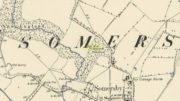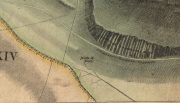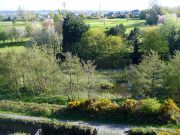Holy Well: OS Grid Reference – TF 3417 7303
Also Known as:
- Halliwell
Archaeology & History

Curiously missing from Thompson’s (1999) Lincolnshire survey, this old watering place can apparently still be found in the appropriately named Holywell Wood, just north of this lovely little hamlet. Shown on the 1887 OS-map of the area, it’s first literary reference seems to be in George Weir’s (1820) early survey of Horncastle district where he gives it a brief mention, saying:
“In a woody dell in this parish is a spring, gently bursting from the rock, called Holy-well, but the name of the saint to whom it was dedicated is not preserved.”
…Like oh so many others. But its ‘holiness’ may devive from other more archaic origins, in the spirit of the woods from whence the waters emerge. Certainly that’s what the poet laureate Alfred Lord Tennyson would have had us believe. He grew up in Somersby village and this old well was one of his places of inspiration. When the local writer H.D. Rawnsley (1900) described Tennyson’s affection for this site, he told us that,
“Alfred peopled that Holywell Wood with forms of fairies, and made the whole surrounding circle of the hills, a theatre for enchantment and chivalry.”

Nature can certainly do that to anyone who wanders Her body with open reverence.
Although the place is now quite overgrown, it wasn’t always this way. There used to be a well-trodden path with a gateway at the entrance that took you into the woods and up to the well. Above the gateway there used to be a Latin inscription that read, Intus aquae dulces, vivoque sedilia saxo, Et paulum silvae superest. His utere mecum. (meaning something akin to, “At these sweet waters, by this living seat of stone and small forest remains, Make use of me.”)
When J.C. Walters wrote about it, he told that a “local student” gave him the following particulars:
“A series of steps led down into the well, a post was fixed in front of it, and a cross-bar extended thence to the rock. On the cross-bar was a ring with a rope attached, so that the bather might safely descend into the well and enjoy the healing virtues of the stream which rushed from the rock. Geologists say that the wold villages are so closely placed on account of the superior quality of the water which springs up wherever the Spilsby sandstone meets the Kimmeridge clay. Susan Epton (Mrs. Thompson), Miss Emily Tennyson’s maid, tells me that she can remember the time when visitors came in scores to “take the waters.””
Some of this was later echoed in Rawnsley’s (1900) biographical account of Tennyson. He talked with a local sexton about the folklore of the area who told him of his memories:
“Halliwell wasn’t growed up then; there was a bath-house with steps down to the watter, and fwoaks in carriages came from far and near to drink it. Wonderful watter! it was nobbut a bit sen, that our owd nebbur was liggin’ adying and he axed for a cup o’ watter from the Holy Well, and they sent and fetched it, and he took it and went off upon his feet. Why, i’ my time theer was a school-house down in Halliwell Wood, and a skittle halley close by the well, but all them things is changed now, excep the snowdrops, and they coomes oop reg’lar, a sight on ’em i’ Halliwell.”
References:
- Harte, Jeremy, English Holy Wells – volume 2, Heart of Albion Press: Wymeswold 2008.
- Howitt, William, Homes and Haunts of the Most Eminent British Poets – volume 2, Richard Bentley: London 1849.
- Rawnsley, H.D., Memories of the Tennysons, James MacLehose: Glasgow 1900.
- Thompson, Ian, Lincolnshire Springs and Wells, Bluestone: Scunthorpe 1999.
- Walter, J. Conway, Records of Woodhall Spa and Neighbourhood, W.K. Morton: Horncastle 1899.
- Walters, John Cuming, In Tennyson Land, George Redway: London 1890.
- Weir, George, Historical and Descriptive Sketches of the Town and Soke of Horncastle, Sherwood, Neely & Jones 1820.
© Paul Bennett, The Northern Antiquarian
The map could not be loaded. Please contact the site owner.

